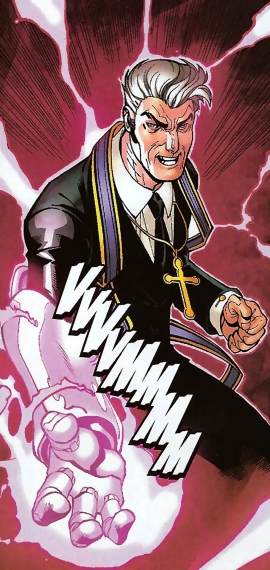There's a certain point in a narrative where a certain subplot either needs to be abandoned or shoved back into the spotlight. It's like that point in a poker game where pushing all the chips to the center of the table is the only sound tactic left. It's a major risk and one that potentially undermines the entire foundation of a story, but the payoff is significant. For the time-displaced X-men in X-men Blue, the time is right for that kind of gamble.
There's no getting around it. Since arriving from the past in the pages of All-New X-men, the mission of the original five X-men seems to change every other week. One week, they're trying to stop Cyclops from ushering in a full-blown mutant genocide. The next, they're joining Cyclops to become mutant revolutionaries. The week after that, they're working with Magneto, the same guy who tried to kill them on their first mission. While it's not uncommon for teenagers to have erratic priorities, time travel seems to exacerbate the situation for the time-displaced X-men.
Beyond these varying missions and allegiances, though, there remains one common, unresolved thread. These time-displaced X-men are, for reasons not yet explained, cannot go back to the future. The events of X-men: Battle of the Atom establish that there is something keeping these time traveling teenagers stuck in the future. The nature of that mechanism is vague and rarely hinted it. For the most part, it's like Spider-Man's marriage in that it's overtly ignored for the most part.
In X-men Blue #16, Cullen Bunn and Thony Silas finally revisit this issue in a way that requires them to push those proverbial chips to the center of the table. It all happens quickly and under the backdrop of some typical teenage melodrama that always seems to find its way into the pages of X-men Blue. The mixture and transitions aren't always seamless, but few things involving teenage melodrama are.
That melodrama is only a small part of a much more serious conflict that has roots that extent back to X-men: Battle of the Atom and beyond. Anyone who has seen Back To The Future more than once understands the erratic and chaotic nature of time travel. Mess with the timeline too much and eventually, it'll get impatient. Whatever patience kept the original five X-men intact in the future seems to have run out, albeit quite suddenly.
There's little build-up or foundation to the sudden fracturing of time. It just starts happening, forcing the time-displaced X-men to react on the spot. Part of that reaction involves them engaging in more time travel. On the surface, that seems like fighting fire with napalm. In this rare instance, though, it makes sense and it addresses an important issue that has remained vague since X-men: Battle of the Atom.
Even those who haven't seen Back To The Future understand on some levels that time travel, especially one that involves changing the past, tends to incur an unpredictable impact on the present. For the most part, the impact of the original five X-men being in the future hasn't been that significant. The final few issues of Dennis Hopeless' run on All-New X-men even imply that their presence may not affect the timeline at all, which undermines the entire premise of a time travel story to begin with.
Like the events of X-men: Battle of the Atom, the temporal details remain vague. However, X-men Blue #16 ditches much of those subtleties and makes one thing very clear. The original five X-men's presence is indeed having an impact on the timeline. They aren't just a bunch of clones or alternate versions of themselves from a dystopian future, of which the Marvel universe already has plenty. They are from the same timeline and what they do does effect the present. That reaction may have been delayed, but it's happening.
It's an important facet that Bunn and Silas belabor, which helps establish the premise and the stakes of the Cross Time Capers arc that begins in X-men Blue #16. It's an overdue dose of clarity for an issue that many recent stories involving the time-displaced X-men go out of their way to ignore. It's both refreshing and profound in that sense that it gives the story genuine stakes, but still doesn't forget that those involved are teenagers. That means that no matter how serious the story may be, there's going to be some entertaining awkwardness along the way.
There is some of that in X-men Blue #16, but not nearly enough. Much of the melodrama involves ongoing emotional entanglements between Cyclops and Jean Grey. While those kinds of entanglements are a major part of X-men drama, regardless of timeline, they seem somewhat forced. It's as though these two always have to have the same kind of drama thrown in, as though that's the only drama they know. Being teenagers, that's less believable than anyone shooting lasers from their eyes.
Even if the melodrama is forced and the pace is quick, the sheer intensity of X-men Blue #16 make it a solid beginning to what promises to be a chaotic arc involving time travel. Given how X-men Blue is coming off an event that involved Mojo, that's saying something. Bunn's concise storytelling and Silas' colorful lay a solid foundation that has the potential to incur more significant implications than anything the time-displaced X-men have experienced to date. Like Marty McFly though, they will likely have to learn about those implications the hard way.
Final Score 6 out of 10



_002.jpg)







